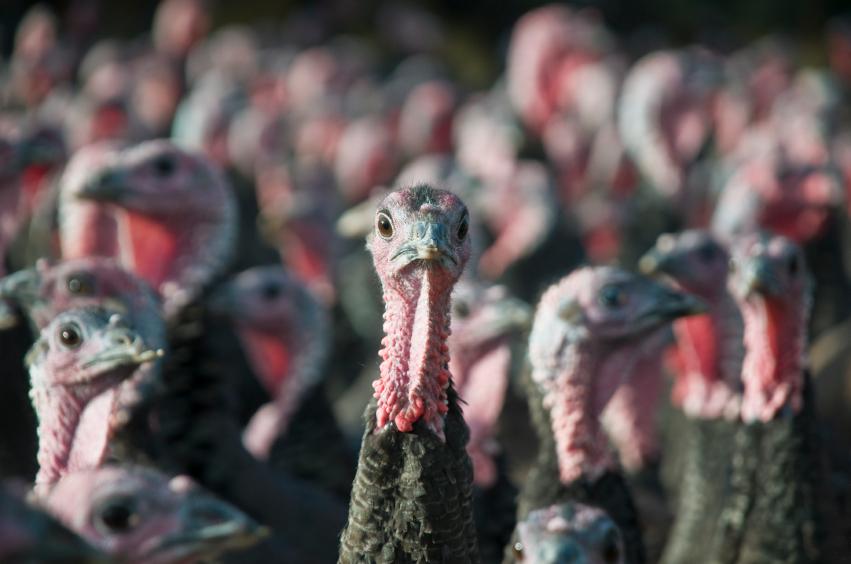A second outbreak of highly pathogenic H5N2 avian influenza in turkeys has been confirmed in Missouri, on a farm halfway across the state from the first outbreak.
The second incident involves a farm housing 21,000 turkeys in the Moniteau County town of Fortuna in the central part of the state, the Missouri Department of Agriculture (MDA) said in a statement late yesterday. A day earlier, the agency had said preliminary test results indicated an outbreak there.
In related news, federal officials said the H5N2 strain found on a Minnesota turkey farm last week matches an isolate from a wild duck in Washington state, and a Wisconsin center will be testing wild birds in the Midwest for the virus.
Missouri outbreaks
The first outbreak was in Asbury, in Jasper County near the state's southwestern corner, and involved a flock of 30,100 turkeys, the agency said. That outbreak was announced Mar 8.
The Jasper County outbreak involved an H5N2 virus, the same subtype that surfaced on a Minnesota turkey farm last week and in wild birds and backyard poultry flocks in Washington, Oregon, and Idaho in the past few months. The virus is believed to be carried by wild birds, and the Minnesota outbreak marked its first appearance in the Mississippi Flyway.
The MDA statement didn't list the virus strain in the second outbreak, but MDA spokeswoman Sarah Alsager confirmed to CIDRAP News this afternoon that it is H5N2.
The MDA statement did not specify how many turkeys at the Fortuna farm were sick or died, but it said all surviving birds would be destroyed.
Although H5N2 has not been known to cause illness in humans, the MDA said the Missouri Department of Health and Senior Services is monitoring workers who may have been exposed to the virus.
MDA Director Richard Fordyce said 18 other poultry farms are within a 6.2-mile radius of the second outbreak, and tests so far have turned up no evidence of avian flu at those sites, according to an Associated Press (AP) report today.
Minnesota virus matches Washington isolate
In other developments, the H5N2 virus that hit a turkey farm in west-central Minnesota looks like a better than 99% match with an H5N2 isolate found in a northern pintail duck in Washington state last December, according to a report that the US Department of Agriculture (USDA) filed with the World Organization for Animal Health (OIE).
The pintail duck was found in Whatcom County in northwestern Washington in mid-December. The county borders a part of southern British Columbia where several commercial poultry farms had been struck by H5N2 outbreaks a few weeks earlier.
A partial genetic sequence of the Minnesota's virus's hemagglutinin and neuraminidase proteins showed more than 99% similarity to the pintail duck virus, USDA officials said in the OIE report, which is dated Mar 6.
Midwest wild-bird testing
Meanwhile, an expert with the US Geological Survey's National Wildlife Health Center (NWHC) in Madison, Wis., said the center will be testing wild birds in the Midwest for the H5N2 virus. The strain has not been reported in any wild birds in the region to date.
Hon Ip, PhD, MS, told CIDRAP News that the NWHC is asking that dead birds found in Minnesota and surrounding areas be submitted for testing. He was expecting to receive today a red-tailed hawk that was found in Olmsted County in southeastern Minnesota and would be testing it. Ip is a microbiologist and director of the NWHC's diagnostic virology laboratory.
He noted that Olmsted County is far from the Minnesota outbreak site, but said, "Nevertheless, sometimes mortality samples are a great source for detecting these outbreaks. That's what we found in Washington. . . . It's worth reminding readers that raptors have been found to be infected with high path H5 viruses, and since that's the top of food chain, they may be an efficient way of monitoring for high-path viruses."
See also:
Mar 9 MDA statement
Mar 10 AP story
Mar 6 OIE report
Related Mar 9 CIDRAP News story





















